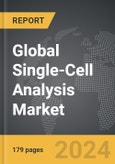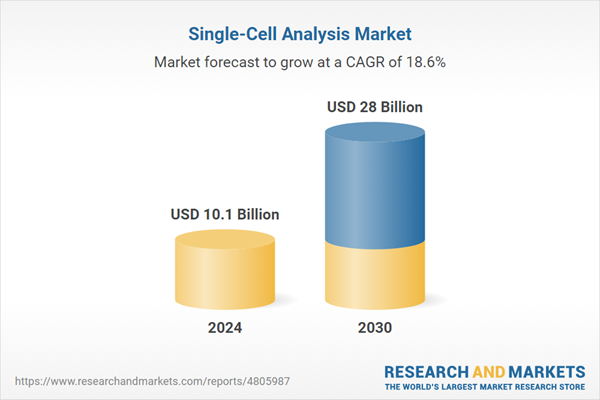The global market for Single-Cell Analysis was valued at US$10.1 Billion in 2024 and is projected to reach US$28.0 Billion by 2030, growing at a CAGR of 18.6% from 2024 to 2030. This comprehensive report provides an in-depth analysis of market trends, drivers, and forecasts, helping you make informed business decisions. The report includes the most recent global tariff developments and how they impact the Single-Cell Analysis market.
Segments: Application (Cancer, Immunology, Stem Cell, Non-Invasive Prenatal Diagnosis, Neurology, Other Applications); End-Use (Academic & Research Laboratories, Biotech & Pharma Companies, Hospitals & Diagnostic Laboratories, Other End-Uses).
Geographic Regions/Countries: World; United States; Canada; Japan; China; Europe (France; Germany; Italy; United Kingdom; and Rest of Europe); Asia-Pacific; Rest of World.
The analysts continuously track trade developments worldwide, drawing insights from leading global economists and over 200 industry and policy institutions, including think tanks, trade organizations, and national economic advisory bodies. This intelligence is integrated into forecasting models to provide timely, data-driven analysis of emerging risks and opportunities.
Global Single-Cell Analysis Market - Key Trends and Drivers Summarized
Why Is Single-Cell Analysis Becoming Indispensable in Biomedical Research?
Single-cell analysis has become indispensable in biomedical research due to its ability to provide highly detailed insights into cellular heterogeneity, allowing researchers to understand complex biological systems at an unprecedented level. Unlike bulk cell analysis, which offers averaged data across a population of cells, single-cell analysis enables the examination of individual cells, revealing unique cellular states and functions. This capability is crucial for fields such as oncology, immunology, and developmental biology, where understanding cellular diversity and behavior is key to identifying disease mechanisms, discovering biomarkers, and developing targeted therapies. As a result, single-cell analysis is increasingly being adopted in academic research, pharmaceutical development, and clinical diagnostics to advance precision medicine and improve patient outcomes.How Are Technological Advancements Enhancing the Capabilities of Single-Cell Analysis?
Technological advancements are significantly enhancing the capabilities of single-cell analysis by improving the accuracy, throughput, and accessibility of data collection and interpretation. The development of high-throughput single-cell RNA sequencing (scRNA-seq), mass cytometry, and microfluidics-based platforms has enabled the simultaneous analysis of thousands of individual cells, providing a comprehensive view of cellular heterogeneity. Moreover, innovations in multi-omics approaches, which integrate genomics, transcriptomics, proteomics, and metabolomics data, are expanding the scope of single-cell analysis beyond just RNA expression. The integration of artificial intelligence (AI) and machine learning (ML) for data analysis and interpretation is also streamlining the extraction of meaningful insights from complex datasets. These advancements are making single-cell analysis more robust, scalable, and user-friendly, thereby driving its adoption across various research and clinical settings.Which Market Segments Are Leading the Adoption of Single-Cell Analysis?
Types of single-cell analysis technologies include consumables (reagents, kits, and instruments) and instruments (flow cytometers, mass spectrometers, and sequencing platforms). Applications of single-cell analysis span cancer research, immunology, neurology, stem cell research, and developmental biology, with cancer research and immunology leading the market due to the high demand for understanding tumor microenvironments and immune cell profiling. End-users include academic and research institutions, pharmaceutical and biotechnology companies, and hospitals and diagnostic laboratories, with academic and research institutions being the primary adopters due to their focus on basic research and translational studies. Geographically, North America and Europe are the largest markets for single-cell analysis due to strong research funding, advanced healthcare infrastructure, and a high number of biotech startups, while Asia-Pacific is emerging as a high-growth region driven by expanding biomedical research activities and increasing healthcare investments.What Are the Key Drivers of Growth in the Single-Cell Analysis Market?
The growth in the single-cell analysis market is driven by several factors, including the rising demand for precision medicine and targeted therapies, technological advancements in high-throughput and multi-omics single-cell platforms, and the increasing use of single-cell analysis in cancer research, immunology, and neurology. The development of user-friendly, automated, and scalable single-cell analysis systems is driving market adoption among academic researchers, pharmaceutical companies, and clinical laboratories. The focus on integrating AI and machine learning for efficient data analysis, interpretation, and visualization is expanding the market reach among diverse end-users. The growing use of single-cell analysis in drug discovery, biomarker development, and personalized treatment strategies, coupled with the demand for innovative, cost-effective, and high-precision tools, is creating new opportunities for market growth. Additionally, the increasing investments in R&D for non-invasive, label-free, and high-resolution single-cell analysis methods are further supporting market expansion.Report Scope
The report analyzes the Single-Cell Analysis market, presented in terms of units. The analysis covers the key segments and geographic regions outlined below.Segments: Application (Cancer, Immunology, Stem Cell, Non-Invasive Prenatal Diagnosis, Neurology, Other Applications); End-Use (Academic & Research Laboratories, Biotech & Pharma Companies, Hospitals & Diagnostic Laboratories, Other End-Uses).
Geographic Regions/Countries: World; United States; Canada; Japan; China; Europe (France; Germany; Italy; United Kingdom; and Rest of Europe); Asia-Pacific; Rest of World.
Key Insights:
- Market Growth: Understand the significant growth trajectory of the Cancer segment, which is expected to reach US$11.1 Billion by 2030 with a CAGR of a 20.5%. The Immunology segment is also set to grow at 19.4% CAGR over the analysis period.
- Regional Analysis: Gain insights into the U.S. market, valued at $2.7 Billion in 2024, and China, forecasted to grow at an impressive 17.1% CAGR to reach $4.1 Billion by 2030. Discover growth trends in other key regions, including Japan, Canada, Germany, and the Asia-Pacific.
Why You Should Buy This Report:
- Detailed Market Analysis: Access a thorough analysis of the Global Single-Cell Analysis Market, covering all major geographic regions and market segments.
- Competitive Insights: Get an overview of the competitive landscape, including the market presence of major players across different geographies.
- Future Trends and Drivers: Understand the key trends and drivers shaping the future of the Global Single-Cell Analysis Market.
- Actionable Insights: Benefit from actionable insights that can help you identify new revenue opportunities and make strategic business decisions.
Key Questions Answered:
- How is the Global Single-Cell Analysis Market expected to evolve by 2030?
- What are the main drivers and restraints affecting the market?
- Which market segments will grow the most over the forecast period?
- How will market shares for different regions and segments change by 2030?
- Who are the leading players in the market, and what are their prospects?
Report Features:
- Comprehensive Market Data: Independent analysis of annual sales and market forecasts in US$ Million from 2024 to 2030.
- In-Depth Regional Analysis: Detailed insights into key markets, including the U.S., China, Japan, Canada, Europe, Asia-Pacific, Latin America, Middle East, and Africa.
- Company Profiles: Coverage of players such as Agilent Technologies, Inc., Beckman Coulter, Inc., Becton, Dickinson and Company, Bio-Rad Laboratories, Inc., Fluidigm Corporation and more.
- Complimentary Updates: Receive free report updates for one year to keep you informed of the latest market developments.
Some of the 11 companies featured in this Single-Cell Analysis market report include:
- Agilent Technologies, Inc.
- Beckman Coulter, Inc.
- Becton, Dickinson and Company
- Bio-Rad Laboratories, Inc.
- Fluidigm Corporation
- GE Healthcare
- Illumina, Inc.
- Merck KgaA
- Qiagen NV
- Thermo Fisher Scientific, Inc.
Tariff Impact Analysis: Key Insights for 2025
Global tariff negotiations across 180+ countries are reshaping supply chains, costs, and competitiveness. This report reflects the latest developments as of April 2025 and incorporates forward-looking insights into the market outlook.The analysts continuously track trade developments worldwide, drawing insights from leading global economists and over 200 industry and policy institutions, including think tanks, trade organizations, and national economic advisory bodies. This intelligence is integrated into forecasting models to provide timely, data-driven analysis of emerging risks and opportunities.
What’s Included in This Edition:
- Tariff-adjusted market forecasts by region and segment
- Analysis of cost and supply chain implications by sourcing and trade exposure
- Strategic insights into geographic shifts
Buyers receive a free July 2025 update with:
- Finalized tariff impacts and new trade agreement effects
- Updated projections reflecting global sourcing and cost shifts
- Expanded country-specific coverage across the industry
Table of Contents
I. METHODOLOGYII. EXECUTIVE SUMMARY2. FOCUS ON SELECT PLAYERSIII. MARKET ANALYSISREST OF WORLDIV. COMPETITION
1. MARKET OVERVIEW
3. MARKET TRENDS & DRIVERS
4. GLOBAL MARKET PERSPECTIVE
UNITED STATES
CANADA
JAPAN
CHINA
EUROPE
FRANCE
GERMANY
ITALY
UNITED KINGDOM
REST OF EUROPE
ASIA-PACIFIC
Companies Mentioned (Partial List)
A selection of companies mentioned in this report includes, but is not limited to:
- Agilent Technologies, Inc.
- Beckman Coulter, Inc.
- Becton, Dickinson and Company
- Bio-Rad Laboratories, Inc.
- Fluidigm Corporation
- GE Healthcare
- Illumina, Inc.
- Merck KgaA
- Qiagen NV
- Thermo Fisher Scientific, Inc.
Table Information
| Report Attribute | Details |
|---|---|
| No. of Pages | 179 |
| Published | April 2025 |
| Forecast Period | 2024 - 2030 |
| Estimated Market Value ( USD | $ 10.1 Billion |
| Forecasted Market Value ( USD | $ 28 Billion |
| Compound Annual Growth Rate | 18.6% |
| Regions Covered | Global |









